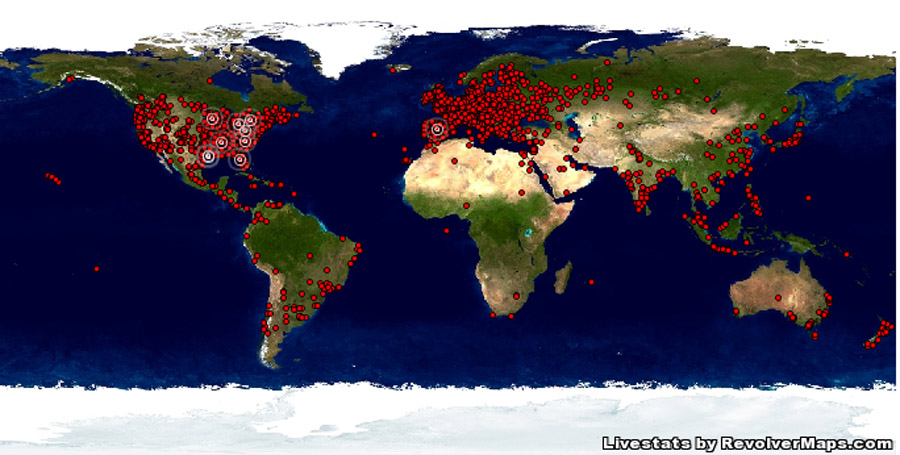Difference between revisions of "December 28, 2009"
| Line 6: | Line 6: | ||
<em>LPOD visitors map from [http://www.revolvermaps.com/?target=enlarge&i=07jzuG9zX2e&wid=1&nostars=false&color=ff0000&m=8&ref=null Revolver Maps]</em><br /> | <em>LPOD visitors map from [http://www.revolvermaps.com/?target=enlarge&i=07jzuG9zX2e&wid=1&nostars=false&color=ff0000&m=8&ref=null Revolver Maps]</em><br /> | ||
<br /> | <br /> | ||
| − | The rotating globe at the bottom of every LPOD page shows a red dot for each visit. This Mercator version of the map shows that over the last 6 weeks LPOD visitors have come from six continents (no lunar observing in Antarctica?) and many countries. It is not surprising that the majority come from North America and Europe, which are locations of thousands of amateur and professional astronomers. Many visitors also come, unsurprisingly, from Japan, Australia and New Zealand. I am pleased to see strong interest in China and India, two countries that have recently orbited their first lunar probes. One hundred and thirty-four visits have come from the Philippines, about a fourth from the programming group that is creating our Second Life [http://www.youtube.com/watch?v=TXpTKp35clg MoonWorld] educational experience. Scattered visits to LPOD from people in South America, Africa, the Mid-East, and South-East Asia are encouraging, showing that interest in the Moon is worldwide. | + | The rotating globe at the bottom of every LPOD page shows a red dot for each visit. This Mercator version of the map shows that over the last 6 weeks LPOD visitors have come from six continents (no lunar observing in Antarctica?) and many countries. It is not surprising that the majority come from North America and Europe, which are locations of thousands of amateur and professional astronomers. Many visitors also come, unsurprisingly, from Japan, Australia and New Zealand. I am pleased to see strong interest in China and India, two countries that have recently orbited their first lunar probes. One hundred and thirty-four visits have come from the Philippines, about a fourth from the programming group that is creating our Second Life [http://www.youtube.com/watch?v=TXpTKp35clg MoonWorld] educational experience. Scattered visits to LPOD from people in South America, Africa, the Mid-East, and South-East Asia are encouraging, showing that interest in the Moon is worldwide. <br /> |
<br /> | <br /> | ||
<em>[mailto:tychocrater@yahoo.com Chuck Wood]</em><br /> | <em>[mailto:tychocrater@yahoo.com Chuck Wood]</em><br /> | ||
Latest revision as of 19:46, 27 October 2018
LPODlandia

LPOD visitors map from Revolver Maps
The rotating globe at the bottom of every LPOD page shows a red dot for each visit. This Mercator version of the map shows that over the last 6 weeks LPOD visitors have come from six continents (no lunar observing in Antarctica?) and many countries. It is not surprising that the majority come from North America and Europe, which are locations of thousands of amateur and professional astronomers. Many visitors also come, unsurprisingly, from Japan, Australia and New Zealand. I am pleased to see strong interest in China and India, two countries that have recently orbited their first lunar probes. One hundred and thirty-four visits have come from the Philippines, about a fourth from the programming group that is creating our Second Life MoonWorld educational experience. Scattered visits to LPOD from people in South America, Africa, the Mid-East, and South-East Asia are encouraging, showing that interest in the Moon is worldwide.
Chuck Wood
Yesterday's LPOD: Ruin Line
Tomorrow's LPOD: Rille From Ridge
COMMENTS?
Register, Log in, and join in the comments.



